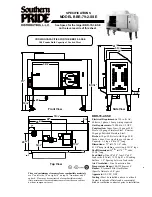
7
2.3 ECO SERIES:
ADJUSTING THE FIREDOOR LOCK
• use a Phillips screwdriver to undo the top and bottom screws
• use a 3 mm hexagonal allen wrench and:
- tighten to reduce play of the closure
- loosen to increase play of the closure
• re-attach the two screws
2.4 THE FLUE SYSTEM
FLUE PIPE CHARACTERISTICS
It is essential that the flue is suitable for the appliance to
work correctly.
The flue system should be inspected by a technician expe-
rienced in flues before installing the appliance, and then be
checked at least once a year.
The flue pipe must conform to the regulations in force
and be kept in perfect condition.
Below are several instructions on fitting the flue pipe.
Non-compliance with these could compromise the applian-
ce’s yield and cause problems with combustion:
• Its height must not be less than 4/5 linear metres
from
the connection to the stove to the base of the chimney pot;
the flue can be narrower if its height is any greater.
• It must be properly sealed and insulated; make sure the
inspection panels close properly and that there are no cracks
on any part of the flue pipe.
• The inside of the pipe must be smooth and the same width
all the way up.
• The flue must be as straight as possible and the chimney pot
must be in a suitable position and at an appropriate pitch, as
indicated in the diagrams and examples below.
• The chimney pot must be double the width of the flue pipe.
FLUE PIPE DIMENSIONS
Guideline for sizing the flue as a function of it’s height:
FLUE PIPE (H)
THERMOCOOKERS
THERMOSTOVES
< 4 m
Draw not
guaranteed
Draw not
guaranteed
4 m < 6 m
Ø 160 mm
Ø 200 mm
> 6 m
Ø 150 mm
Ø 180 mm
If this is not feasible you should contact a flue specialist.
CROSS-SECTION
: the flue pipe’s cross-section depends on
the height of the flue and the thermal power of the installed
cooker. To ensure the optimal yield of our cookers we recom-
mend you use circular flue pipe with smooth interior lining
and of the same length all the way up.
INSULATION
: flue draught pressure also depends on the dif-
ference in the temperature of the hot flue gases and that of
the air outside. The flue pipe must be insulated to restrict
absorption of heat into the walls and therefore avoid conden-
sation, which can cause tarry residues. Use only suitable heat-
and corrosion resistant materials conforming to building and
fire-prevention regulations. You should not use flue pipes
comprising simple or flexible metal tubes, cement tubes for
vents, etc.
DEPRESSION
: the optimal depression (flue draught
pressure) is 0.15 mbar.
a. Flue’s refractory
interior lining or
stainless steel
(min.T400)
b. Prefabricated
external casing
c. Insulation material
c
d
Roof
pitch
Reflux area
0.5 m above
the ridge
b
Roof pitch
15°
a distance > 1,85 m b distance 1,85 m
c 1 m min.
d 0,5 m
30°
a distance > 1,3 m
b distance 1,3 m
c 1,2 m min.
d 0,8 m
45°
a distance > 1,5 m
b distance 1,5 m
c 2 m min.
d 1,5 m
60°
a distance > 1,2 m
b distance 1,2 m
c 2,6 m min.
d 2,1 m
a
english
Содержание EKB110
Страница 2: ...2 ...





































